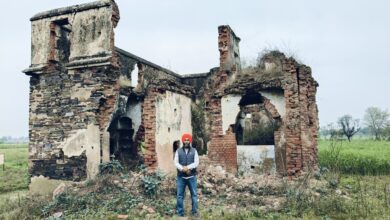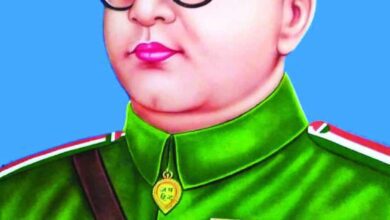The Battle of Saragarhi

The Battle of Saragarhi
Mission aut vin-ce-re aut mor-ri.
By

Col. Parmar, Rattan Singh.
The history of the Nations is written
with the tip of the soldiers’ sword.
Also, the foundation of Nation’s
peace and prosperity are laid
over the spilled blood and bones
and scattered
limbs and ashes of soldiers.


God and soldier, we adorned
At the time of trouble and not before.
The time passed and things righted,
God is forgotten, and soldiers slighted.

The contingent consisting of twenty-one brave, insuperable. and invincible Sikhs soldiers, under dynamic, exuberant, flamboyant leadership of Havildar Ishar Singh, was deployed at Fortress Saragarhi. They all chose to fight to the death in the best tradition of their race and Regiment. The battle is well known outside military schools of instruction. That battle is “considered by some military historians as one of history’s great Last stand.” The battle of Saragarhi is the epitome of raw courage, sheer grit, and unshakable determination.
History records that “the battle of Saragarhi, is one of the eight stories of collective bravery published by UNESCO. The battle has been mentioned as one of the five most significant events of its kind in the world which includes the battle of Thermopylae associated with the heroic stand of small Greek force against the mighty Persian Army of Xerxes in 480 BC.”
The battle of Saragarhi was fought on Sunday, September 12, 1897, by 21 brave, undaunted Sikh soldier’s ex XXXVI Sikh Regiment. The regiment is since redesignated as 4th Battalion, the Sikh Regiment. They fought against ten to twelve thousand Afghan guerrillas under command Gul Badshah, able commander and seasoned warrior, well known in art of scientific art of warfare.
All the 21 brave, resolute, and undaunted, Sikh soldiers were fully aware that they were facing mission impossible, a “mission aut vin-ce-re aut mor-ri.” All the 21 brave Sikh were killed fighting. The enemy admitted that they lost more than 200 best guerrillas and another more than 250 were wounded in the battle of Saragarhi.

These brave and invincible Sikh preferred sacrifice than surrender. That action was a self-sought sacrifice. The defenders fully knew that that was a mission impossible.
Tough times never last, but tough people do.
n
Saragarhi after the battle.
| ਸਲੋਕ ਕਬੀਰ ॥ | |
| ਗਗਨ ਦਮਾਮਾ ਬਾਜਿਓ ਪਰਿਓ ਨੀਸਾਨੈ ਘਾਉ ॥ਖੇਤੁ ਜੁ ਮਾਂਡਿਓ ਸੂਰਮਾ ਅਬ ਜੂਝਨ ਕੋ ਦਾਉ ॥੧॥ | |
| ਸੂਰਾ ਸੋ ਪਹਿਚਾਨੀਐ ਜੁ ਲਰੈ ਦੀਨ ਕੇ ਹੇਤ ॥ਪੁਰਜਾ ਪੁਰਜਾ ਕਟਿ ਮਰੈ ਕਬਹੂ ਨ ਛਾਡੈ ਖੇਤੁ ॥੨॥੨॥ | |
Shalok Kabir॥
Gagan damaamaa baajio pario Neesaanai ghaao(u) ॥ Khait(u) jo(u) mandio soorma ab joojhan to daao(u) ॥ Soora so pahichaaneeai jo(u) larai deen kai hait॥ Purjaa purjaa kat(i) marai kabhoo na chhaadai khait॥2॥2॥
Shalok Kabir॥
The battle drums beat in the sky of the mind; aim is taken, and the wound inflicted. The spiritual warriors enter the battlefield; now is the time to fight||1|| That person alone is known as spiritual warrior who fights in the defense of religion and the meek. He may be cut apart, limb by limb but the warrior never leaves the battlefield. ||2|| ||2|| Guru Granth Sahib, page 1105.
Recognition
The heroic deeds of those invincible 21 Sikh soldiers were placed before Her Majesty, Queen Victoria. The story when narrated in the British Parliament drew from all the members standing ovation in the memory of those undaunted brave Sikh soldiers who defended the post of Saragarhi. All those valiant Sikh soldiers, the heroes of the battle of Saragarhi, were decorated with the “Indian Order of Merit” the highest distinguished

Indian Order of Merit
gallantry award for conspicuous bravery, in the face of the enemy, conferred upon Indian troops that time. Besides, the dependents of all those brave soldiers of the XXXVI (36) Sikh Regiment were awarded each Indian Rupees. five hundred and fifty acres of farmland.
Never in the Commonwealth’s military history had the equivalent of 21 Victoria Crosses been awarded to a single unit in a single battle for conspicuous bravery in the face of the enemy.
The Roll of Honor, with Regimental Numbers –
165. Havildar Ishar Singh. Detachment Commander
332. Naik Lal Singh. 546. Lance Naik Chanda Singh.
163. Sepoy Ram Singh. * 182. Sepoy Sahib Singh.
287. Sepoy Ram Singh. 359. Sepoy Hira Singh.
492. Sepoy Uttar Singh. 687. Sepoy Daya Singh.
760. Sepoy Jiwan Singh. 791. Sepoy Bhola Singh.
814. Sepoy Gurmukh Singh. * 834. Sepoy Narayan Singh.
871. Sepoy Jiwan Singh. * 1221. Sepoy Nand Singh.
1257. Sepoy Bhagwan Singh. 1265. Sepoy Bhagwan Singh.
1321. Sepoy Sundar Singh. 1556. Sepoy Buta Singh.
1651. Sepoy Jivan Singh. 1733. Sepoy Gurmukh Singh.
(*) No. 814 Sepoy Gurmukh Singh and No. 871 Sepoy Jiwan Singh belonged to one and the same village, Damunda (being further investigated), in the district of Jalandhar, Punjab. Both belonged to Minhas clan. No. 163 Sepoy Ram Singh belonged to village Kandola. Both the villages are close by near Adampur Doaba. Both the villages are called Damudna- Kandola though the villages maintained their independent identity. The descendant of Sepoy Ram Singh’s brother is settled here in Canada. He is Havildar Amarjit Singh Bains settled in Rocky View County, Alberta. He is staying with his son Sardar Baldev Singh Bains and his wife Paramjit Kaur Bains.
All the twenty-one Saragarhi Bahadurs were not from Majha region of Punjab (India). I had approached the Sikh Regimental Centre, their editorial board but with no success. In 2023, I spoke to the then Commanding Officer of 4th Battalion the Sikh Regiment. But could not find the answer.
My other concern was that Sikh soldiers fought on almost all fronts overseas during WW1, including the famous battle of Flanders, that was fought in 1915. Unfortunately, NO Sikh soldier was decorated with Victoria Cross, the most prestigious highest war time award. I could find no answer to this also.
The first Sikh who was decorated with Victoria Cross was, then Sepoy and later Honorary Captain, Ishar Singh who earned that highest war time award for conspicuous bravery in the face of the enemy on April 10, 1921, near Haidai, Waziristan, then in India.
Let us not be confused. Only 40 Muktas who attained martyrdom fighting in the battle of Khidrana, present day Mukatsar Sahib were from Majha region.
There were two Gurmukh Singh. It is not clear which of the two was the signaller who sent the last signal and was the last to attain martyrdom.
STATUE
In 2021, the British Government, honoring the dynamic leadership of Havildar Ishar Singh,

erected his statue in England.
The valor and gallantry displayed by those 21 Sikh soldiers of 36 Sikh Regiment, the heroes of the battle of Saragarhi, is summed up in these verses –
On Saragarhi’s ramparts died,
the bravest of the brave.
Beneath Saragarhi’s ruined walls,
they found a fitting grave.
For Saragarhi bears the fame,
they gave their lives to save
Here is stanza from Guru Gobind Singh’s compositions –
‘Chiriyan Ton Mein Baaz Turaoon,
Sava Lakh Se Ek Ladaoon,
Tabay Gobind Singh Naam Kahaoon’,
I shall call myself (Guru) Gobind Singh
if I can make meek sparrows pounce
upon the mighty hawks and tear them,
Only if one combatant of my force faces a
lakh and quarter (one hundred and
twenty-five thousand) legion of the enemy.

At Saragarhi, the meek force ex 36 Sikh Regiment consisting of only twenty-one undaunted Sikh soldiers under the dynamic leadership of Havildar Ishar Singh proved that. They left the enemy, mighty hawks of 10 -12 thousand, with their ‘none bleeding.
The battle of Saragarhi gave the concept of “Last man, last bullet.”
Mine Efforts
I penned all the collected information about that great battle from various resources including the Saragarhi Gurdwara at Amritsar. Those days I was NOT lucky enough to have the facilities of internet. I mailed the article to couple of newspapers and magazines and those were published from City of Calgary, in the Province of Alberta, Canada. The media proudly ran the article that appeared on Friday, September 12, 1997. On the eve of centenary commemoration of the great battle, I also appeared on TV and Radios. Later, in 2003, I displayed relevant material in The Military Museum, Calgary. My interview appeared under Calgary File, interviews on the internet.

Author in front of showcase


;

I conclude with the Motto of the Sikh Regiment.
Nischay Kar Apni Jeet Karoon.
With determination, I will be triumphant.

I am given to understand that some vested interest had copied it and claim his own. The uniform and medals, and other material, are mine. Some pictures were got from the War Office London.






